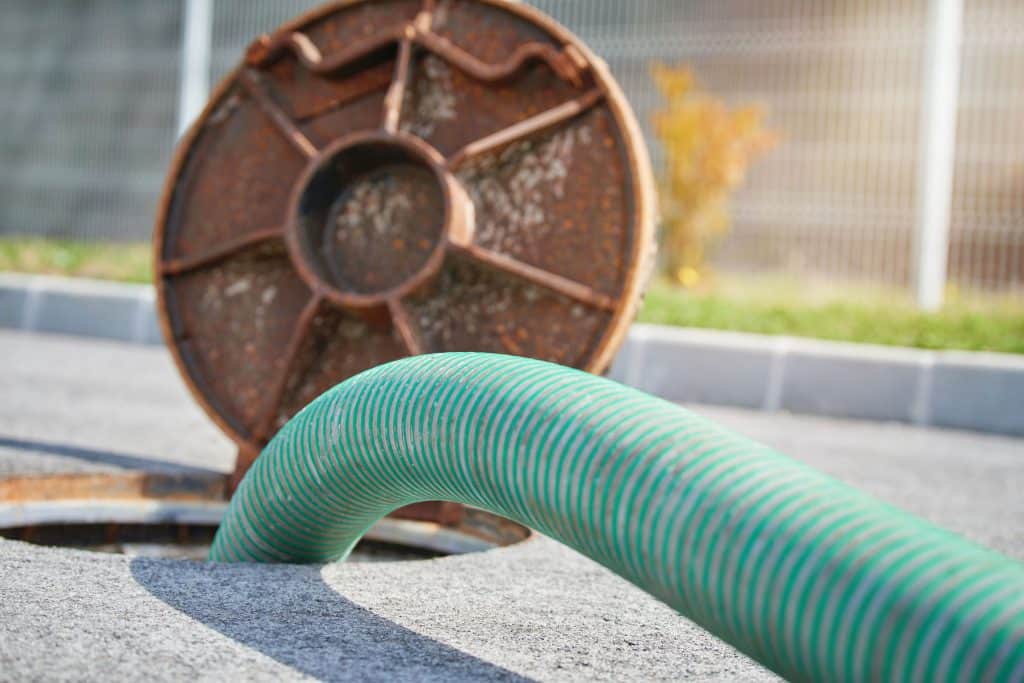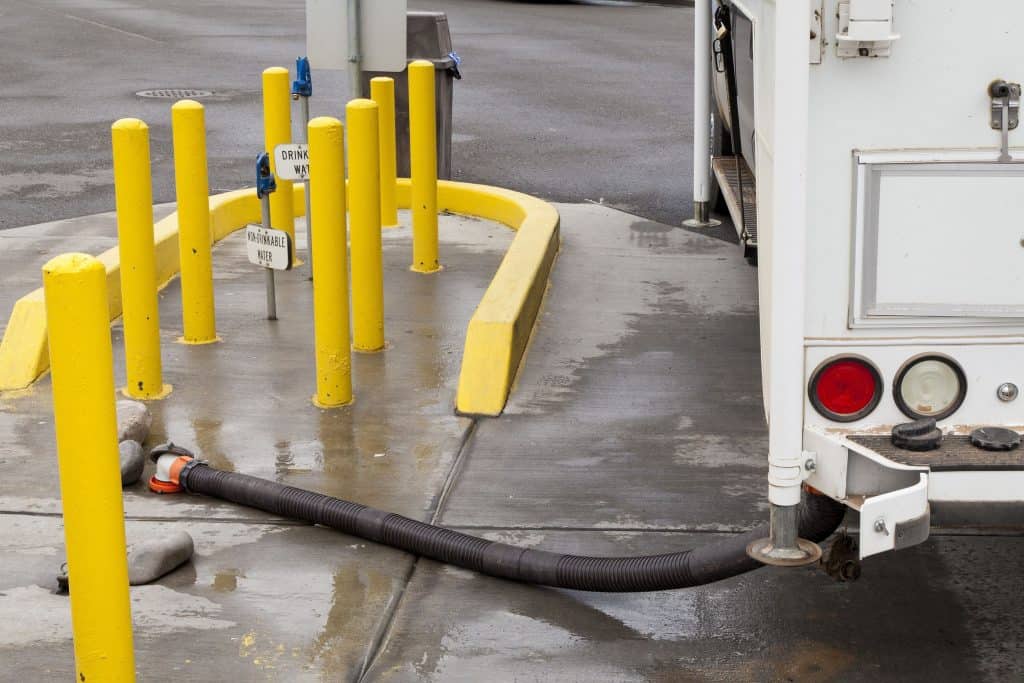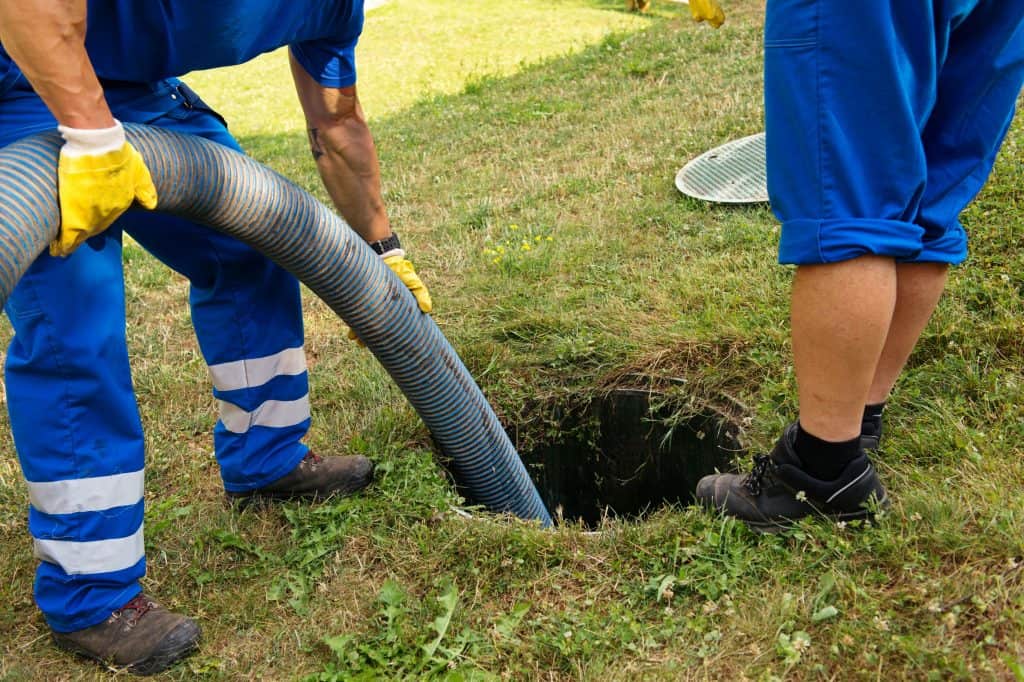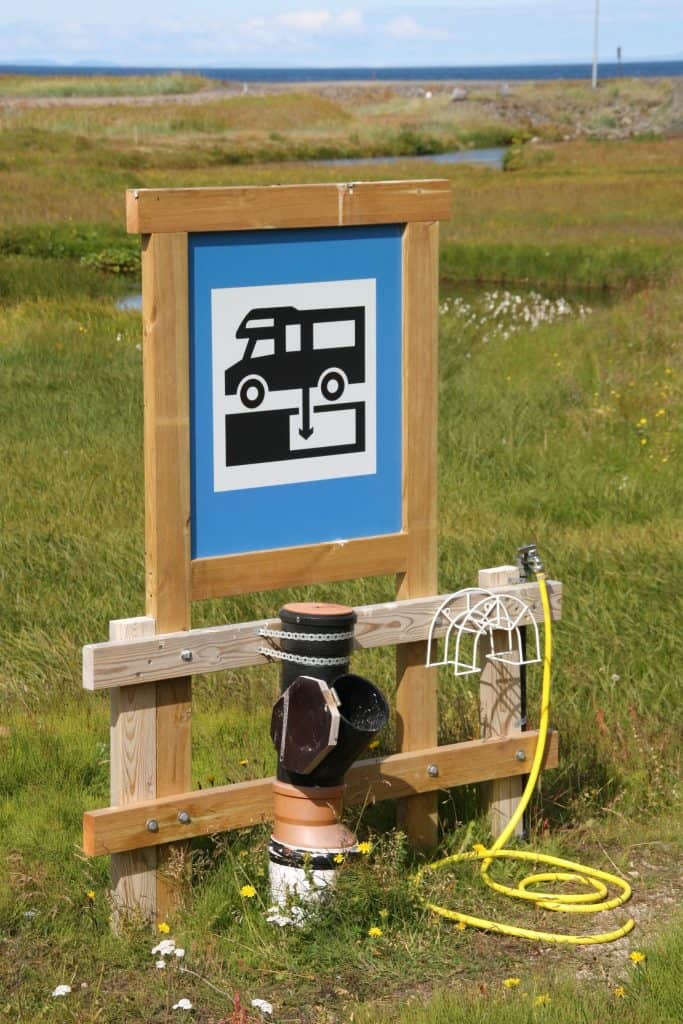
So, you’ve been camping out for a while and realize that it’s time for you to empty your black water tank. You’re staying with a friend and you want to know if you can use their septic system to dump the contents of your holding tanks.
Can you dump your black water into a Home Septic Tank? The good news is that you can dump your RV black water into a residential septic tank in a few short steps. Using a garden hose for flushing out the tank, and some jets, you can easily finish clearing your black water tank in about 15 minutes.
We must first understand the very basics of our home and RV Septic Systems before we clear out and install anything.
Understanding Home Septic Tanks
Before we install anything or empty anything into or home septic tank, we should first educate ourselves on the home septic tank.
The Basics of the Septic Tank
If you are new to working with Septic Tanks, then you should know that almost all Septic Tanks are divided into two main parts:
Solids/Holding Tank: Functions exactly as it sounds. The Solids Tanks is responsible for holding all liquids and solids that you flush down your toilet. The solids settle to the bottom of the tank while the liquids fill to the top until they eventually overflow into the…
Drain Field: Here is where any leftover wastewater is distributed through pipes throughout the land and cleansed of any and all dangerous impurities.
Now that the home Septic Tank is understood better, we can start finding ways to empty the Black Tank.
Laws and Reservations
Before you begin your setup for dumping your Black and Grey Water tanks from your RV, you must first consult with someone in your local area.
Sometimes, it’s all about the name. In some cases, local areas will not allow a person to have a “Dump Station” within private property.
However, referring to it as something else entirely can occasionally help you out, and officials will allow you to dump your tanks into a Home Septic System.
In other cases, it’s really about the dump station itself and what it means for your Septic Tank.
One of the biggest reservations about creating a home dump station for RVs is that their tanks can sometimes hold chemicals (such as bleach used for cleaning) that destroy the bacteria that break down waste in our Home Septic Tanks.
As you can imagine, this brings about many problems – especially when it comes to having clean water.
If the bacteria are gone, water can’t be cleaned and sent back out into the environment.
So, always look into what your local government has to say about this topic before making the decision for yourself.
If your local government allows you to dump your holding tanks at home, just make sure you are using the proper chemicals to clean the tanks out.
Understanding RV Holding Tanks

Even more important than understanding your home septic tank\, in this case, is learning the basics or your holding tanks.
Before you begin dumping out your holding tanks, it would do you some good to understand the differences and what they mean for your RV.
RV Holding Tanks are Separated into 3 categories.
- Freshwater tank
- Grey Water tank
- Black Water tank
Each of these tanks serves its own special purpose for living in your RV.
So, what do these holding tanks do for the RV?
The Freshwater Tank
The Freshwater Tank is what a person would use in their RV for drinking water and when taking showers or doing the dishes.
Basically, the Freshwater Tank is what later on provides you with a full Grey Water and Black Water Tank.
You never want your Freshwater to freeze, and it is one of the first things you should be insulating when going camping in the winter.
Remember…
No freshwater – No steady water supply.
It is also a good role of thumb for you to remember – Never mix your Freshwater hose with your Grey or Black Water hose.
Mixing these hoses would be very bad and could make you very, very sick.
The Grey Water Tanks
The Grey Water is exactly what it sounds like. It isn’t exactly freshwater, but it isn’t totally disgusting like Black Water either.
The Grey Water Tank in an RV holds all of the water that comes from your sinks, shower, etc.
The Grey Water is basically anything that doesn’t come from flushing your toilet but that has already been used by you in other ways.
After having dumped the Black Water Tank, you should go ahead and dump out the Grey Water Tank.
They Grey Water will help flush out the pipes and hoses that you used when emptying the Black Water Tank.
The Black Water Tank – Sewage
The Black Water Tank in an RV is what holds everything that comes with flushing your toilet.
Black Water is a combination of chemicals, urine, feces, and the water that you flushed with it.
When dumping out the Holding Tanks in an RV, you always want to start with the Black Water Tank. Black Water Tanks contain all of the gross and nasty stuff that you want to flush out of your pipes with Grey Water.
To clarify, opening the Grey Water Valve after the Black Water Valve will rinse anything that was caught in your hose when emptying the Black Water Tank.
The general rule for emptying your Black Water Tank is to wait until it is about two-thirds of the way full.
Depending on the number of people you are traveling with, you may have to empty your Black Water Tank about once a week at a dump station.
The Simplest Way to Dump Your RV
Before you go about installing a Dump for your RV, there is a much simpler and faster way to dump the wastewater into a septic system.
For this method, you will need:
- A Commercial Garden Hose
- RV Waste Pump (I recommend using the FloJet Portable Macerator Waste Pump)
- Gloves
- Clear Elbow (Optional)
Easy enough, right? You would be correct.
When you have these materials you can begin setting everything up.
Follow the steps below to learn how you can dump your RV Grey and Black Water tanks in a residential septic tank.
Setting Up:
To get started, pull your RV into the yard for a closer set up.
Next, go ahead and attach your Waste Water Macerating Pump to the RV.
Now go and add on your garden hose and set it up so that its contents will fill directly into a toilet or into the septic tank.
(You may want to place something heavy on top of the hose to keep it in place).
If you are emptying your tank directly into the septic tank, then you may need to dig a little bit. Disregard this if you decide to dump the contents of the tank in the toilet.
How to Empty the Holding Tanks into the Septic System
To begin…
- Put on a pair of rubber disposable gloves
- Open the screw cap of your Black Water Tank and hook up sewer hose. Turn on the Waste Water Pump.
- If your tank is completely full, the entire process of emptying the tank should take about 15 minutes at the most.
- Once the tank is empty, go on and turn off the pump.
- You will want to go ahead and open your Grey Water to clean and flush out anything that may be left in the garden hose.
- Now turn on clean water to rinse and clean out all of the Holding Tanks and the Garden Hose.
- Once everything is good and clean, you can now close up the Black and Grey Water Tanks and remove everything else from the side of your RV.
If you’d really like to, you can purchase a clear elbow cap that attaches to your RV before you add on the Macerating Pump. This way it is clear to you that the holding tank is completely empty (as you can now see the water) before closing valves.
You may also want someone on the other end making sure that your garden hose isn’t going anywhere and that that nasty water isn’t going anywhere but the toilet.
Once you are sure everything is empty and clean, you are done!
Why This Method Works So Well
Using this method is really nice. If you have decided to purchase a Macerating pump, then you understand how it works. If you haven’t, then here is a quick run-down.
A Macerating Pump is designed for high-pressure situations. It breaks down the solids in your Gray and Black Water Tanks to allow them to better flow through smaller hoses, such as a garden hose.
By pulverizing the solids, combined with the pressure of the pump itself, your wastewater can even be transported uphill if need be.
There are exceptions to this now. If you have a newer RV, then you may be lucky enough to actually have a macerating pump already built into your RV.
IF this is the case, it makes set up a tiny bit easier for you, but you still follow the same steps and process.
If this isn’t the case, have no fear, you can still easily find this product online and buy it for a relatively reasonable price.
Exceptions

I have seen some cases where a person has taken all of the correct measurements and made sure everything is at the right angles and created a permanent tube for the contents of a holding tank to their own dumping stations.
All it takes is some glue, pvc pipes, nails, a shovel, etc.
While this takes way more work and requires a little bit of digging in your yard, this does act as a more permanent solution for you. And it requires fewer hookups.
All you would need to do once this is done is connect a hose to the piping in your yard, then connect the other end of the hose up to the opening in your RV and release the black water first, followed by the grey water.
Any and all wastewater should go directly into the underground septic tank.
This is a nice creative solution if you are going to be camped out in your RV but parked in someone’s yard for an extended period of time.
What to Watch Out For
As with everything else out there, there is a proper way to do things.
As such, there is a proper way for you to be emptying the holding tanks in your RV. Especially if you are planning to dump the tanks in a home septic tank.
Below are some concerns that could pop up if you are not completely careful when emptying your tanks.
A Word to the Wise
Before you begin to open up any valves or turn anything on, make sure that everything has been properly connected and sealed up tight.
The worst thing you can do is spring a leak.
If you have a leak in any part of the system, you are going to have a huge, unpleasant mess on your hands – and it won’t be any fun to clean up.
If you don’t trust me – trust Robin Williams! Don’t be like Robin Williams!
Beware Your Sensor
Most, if not all RVs are equipped with a monitor that begins to tell you when your holding tanks are starting to get full.
There is one main problem that can occur due to this.
Your Sensor is Out of Whack – this is a common occurrence. From what I have observed, these monitors can be triggered by anything. But especially when there is debris stuck in your valves.
When emptying your tanks, make sure that everything is good and clean so that the monitor doesn’t keep going off at the wrong moments. Any leftover gunk will cause your sensor to register that the holding tanks are still full.
So just be extra careful and rinse everything out one more time before putting it all away..
Watch the Temperature
When your holding tanks start to get full – especially in the summertime – your nose may begin to tell you before your sensor will.
An easy way to keep this unpleasantness from happening is by keeping up with emptying the tanks. Especially in the summer, you should be emptying the tanks every couple of days.
The temperature can also dry out your valves if you aren’t careful enough. A simple and easy way method for preventing this is by adding water to the tanks before you think it may really need it.
Pay Attention to Chemicals
Unless you are using specially made cleaning supplies specifically manufactured for your RV – you need to watch out. Especially when dumping your tanks in a residential area.
In our home septic tanks, and even holding tanks, there are special bacteria that allow for the break down of our solids.
These bacteria are important because they prevent the overflow of water in the drain field of a home septic tank.
Chemicals to be wary of include:
- Bleach
- Formaldehyde
- Embalming Fluid (Glutaraldehyde)
- Bronopol
When we use chemicals that aren’t meant for our RVs – we start to ruin our holding tanks and septic tanks by killing all the good bacteria that breaks downs the solids in our waste.
To avoid this issue, the Department of Toxic Substances Control suggests using any public rest stops and bathroom facilities within the area that you are camping.
However, one chemical that seems to be relatively safe to use for those times that you need to be deep cleaning your tanks is a natural digester and deodorizer.
This does exactly what it says – digests and deodorizes everything in your tanks.
I’ve also read of cases where RVers have used laundry detergent to deodorize the holding tanks in their RV.
That being said, this probably isn’t the best solution out there. But, you should be deep cleaning each of your tanks about once a week.
Be Careful About What Goes Down Your Toilet
This one seems pretty obvious to me. But whatever the case may be, there are several reasons you should be careful about what you are flushing.
First and foremost, your toilet can clog. It’s as easy as using the wrong kind of toilet paper.
But secondly, your nice, expensive macerating pump can be broken by the odd items that you may find yourself flushing.
Yes, the macerating pump is meant to break down any solids – but maybe not ALL solids.
As a general rule, if you don’t know whether to flush something down the toilet – just don’t. Throw it away or dispose of it in another way.
Related Reading: What type and brands of toilet paper are safe for the RV?
Alternatives to Dumping RV Tanks
Rather than using the Macerating Pump method where you need to hook things up to your RV and throughout the house, here are three other quick options you can choose from if you so wish.
Acquire a Bucket
This situation really only works if you have already dumped your holding tanks in another area – such as at the campgrounds.
The bucket method is really just there for you on the ride home to be able to take in any of the extra waste water.
The buckets can also hold any cleaning solution that you may be needing to use for cleaning out the holding tanks.
Use a Tote
For situations in which you find yourself without a dump station nearby, a tote can really come in handy.
Totes act as a sort of middleman between your Holding Tanks and the Dump Station. And they are completely portable.
For this method, keep in mind that it is highly recommended that your tote is bigger than the holding tanks of your RV. That way there is no possibility of overflow when filling up the tote.
It’s easy enough. Rather than hooking up your Holding Tanks to a nearby Septic Tank, just connect the hoses to the tote and begin emptying the waste water into the tote.
Eventually, when you have the time, you can transport the tote to a dump station and empty it out there.
You should also be properly cleaning and sanitizing the tote after each use.
If you are interested, I would recommend using the Thetford Portable RV Waste Tote. It runs for about $220.00 on Amazon.
Dump Your RV Waste Tanks Somewhere Else

Unless you are really parked and camping out in you or your friend’s yard, chances are that you will have access to better ways to dump your waste water.
Take advantage of the areas offered by RV Parks for you to clean and empty out your holding tanks.
By using this method, you can avoid all kinds of extra setbacks such as laws that may actually prohibit you from dumping the tanks in a residential septic tank.
Dumping your tanks at the RV Park should require a similar set up to emptying your tanks at home. So the same rules apply. It just requires a little more traveling.
Wrapping Things Up: How Should I Dump My RV Water Tanks?
So, what have we learned about dumping the holding tanks in our RVs? Here is a quick recap of everything you need to know.
- In the end, before you even think about flushing out your Holding Tanks in a Home Septic Tank system, you should understand your local laws.
- Once you have found that it is alright for you to have a Home Dumping Station, gather all of the supplies that you need and connect them to your RV and Residential Septic Tank.
- Make sure that you are turning on the Black Water first, and then opening the valve for the Grey Water Tank after that.
- Understanding the proper use of each of these tanks will help you in knowing why dumping your Holding Tanks must be done in a certain manner.
- Clean out all of the piping, hoses, and tanks and you will quickly be on your way to filling your tanks back up.
- As a reminder, you should be dumping these Holding Tanks no less than once a week. Otherwise, you run the risk of them filling completely, and no one would want that.
- You should be paying attention to any problems that can and will arise every once in a while.
- Simple things such as checking for leaks, avoiding certain chemicals, and rinsing out your tanks are useful when it comes to preventing certain disaster – and even minor annoyances.
- There are alternative methods to this process, such as just dumping the holding tanks at the RV Parks and avoiding waiting until you get to a residential area. In the meantime – while on the road – just use a tote until you can get to a dump station.
- If you get really desperate, just grab a bucket!
As you go on your way and learn more about the manufacturing of your own RV, you should be able to understand how and when you should be dumping out your tanks.
As you learn, you will be on your way to finding simpler and safer methods of taking care of your RV and your septic system.
For now, follow these quick and easy tips and methods to help you on your way to success.
Good luck! And be careful!
Final Thoughts
Campers need not go out and find a RV dump station if they have a septic nearby. That’s great news and can save a lot of time. Also if you are traveling in your RV, don’t forget that many Truck Stops have dump stations that you can use for a small fee.
Read more about what truck stops have to offer for rvers.
Related Questions
Can I leave my black water tank open? You should never leave the Black Water Valve on your RV open. Unless you are emptying the tank, keep it closed. This will prevent it from mixing with any of your other holding tanks.
How do I keep my black and grey water tanks from freezing? Some people who live in RVs full time suggest dumping a bit of antifreeze down your toilet and drains to keep the tanks from freezing. Others suggest disconnecting your water supply from your local water supply.
Can I put bleach in my black water tank
